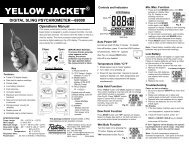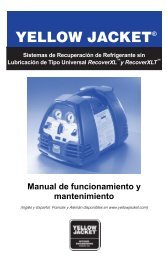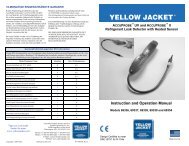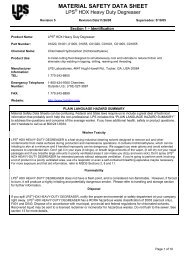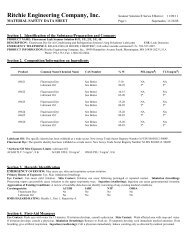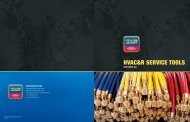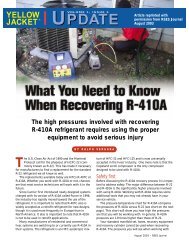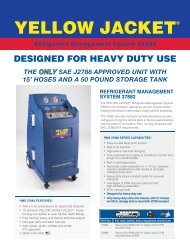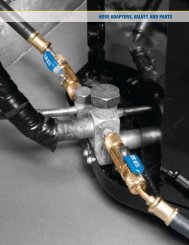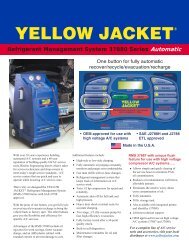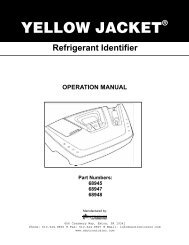Yellow Jacket SuperEvac Premium Vacuum Pump Oil MSDS _10505
Yellow Jacket SuperEvac Premium Vacuum Pump Oil MSDS _10505
Yellow Jacket SuperEvac Premium Vacuum Pump Oil MSDS _10505
Create successful ePaper yourself
Turn your PDF publications into a flip-book with our unique Google optimized e-Paper software.
Ritchie Engineering Material Safety Data Sheet<br />
Ritchie Engineering Emergency: 800-424-9300<br />
YELLOW JACKET Products Division<br />
10950 Hampshire Avenue South Information: 800-769-8370<br />
Bloomington, MN 55438-2623 USA<br />
SECTION 1<br />
CHEMICAL PRODUCT IDENTIFICATION<br />
Product:<br />
Product Numbers:<br />
YELLOW JACKET <strong>SuperEvac</strong> <strong>Premium</strong> <strong>Vacuum</strong> <strong>Pump</strong> <strong>Oil</strong><br />
93091, 93092, 93096, 93191, 93192, 93194<br />
Synonyms/Other:<br />
None<br />
<strong>MSDS</strong> Number: <strong>10505</strong><br />
Product Type:<br />
Industrial <strong>Oil</strong><br />
Revision Date: 8/15/2012<br />
SECTION 2<br />
COMPOSITION INFORMATION<br />
INGREDIENTS CAS # % ACGIH TWA OSHA TWA ACGIH STEL SKIN<br />
64742-54-7 >90% 5mg/m 2 (TLV) 5mg/m 2 (PEL) 10mg/m 2 NO<br />
No Reportable Hazardous Substances(s) or Complex Substance(s)<br />
SECTION 3<br />
HAZARDOUS IDENTIFICATION<br />
This material is not considered to be hazardous according to regulatory guidelines (see <strong>MSDS</strong> Section 15)<br />
Potential Health Effects<br />
Eye: Contact may cause mild eye irritation including stinging, watering and redness.<br />
Skin: Contact may cause mild skin irritation including redness and a burning sensation. Prolonged or<br />
repeated contact can defat the skin, causing drying and cracking of the skin, and possibly dermatitis<br />
(inflammation). No harmful effects from skin absorption have been reported.<br />
Inhalation (Breathing): No information available on acute toxicity<br />
Ingestion (Swallowing): No harmful effects reported from ingestion.<br />
Signs and Symptoms: Effects of overexposure may include irritation of the digestive tract, nausea and<br />
diarrhea. Inhalation of oil mist or vapors at elevated temperatures may cause respiratory irritation.<br />
Pre-Existing Medical Conditions: Conditions which may be aggravated by exposure include skin<br />
disorders.<br />
NFPA Hazard ID: Health: 0 Flammability: 1 Reactivity: 0<br />
Note: This material should not be used for any other purpose than the intended use in Section 1 without<br />
expert advice. Health studies have shown that chemical exposure may cause potential human health risks<br />
which may vary from person to person. See Section 11 for additional Toxicity Information.<br />
SECTION 4<br />
FIRST AID MEASURES<br />
Inhalation:<br />
Remove from further exposure. For those providing assistance, avoid exposure to yourself or others. Use<br />
adequate respiratory protection. If respiratory irritation, dizziness, nausea, or unconsciousness occurs, seek<br />
immediate medical attention. If breathing has stopped, assist ventilation with a mechanical device or use<br />
mouth to mouth resuscitation.<br />
Skin Contact:<br />
Remove contaminated shoes and clothing and cleanse affected area(s) thoroughly by washing with mild<br />
soap and water or a waterless hand cleaner. If irritation or redness develops and persists, seek medical<br />
attention.<br />
Page 1 of 6
Ritchie Engineering Material Safety Data Sheet<br />
Eye contact:<br />
Flush thoroughly with water. If irritation occurs, get medical assistance.<br />
Ingestion:<br />
First aid is normally not required. Seek medical attention if discomfort occurs.<br />
SECTION 5<br />
FIRE FIGHTING MEASURES<br />
Extinguishing Media:<br />
Appropriate Extinguishing Media: Use water fog, foam, dry chemical or carbon dioxide to<br />
extinguish<br />
Inappropriate Extinguishing Media: Straight streams of water<br />
Fire Fighting:<br />
Fire Fighting Instructions: Evacuate area. Prevent runoff from fire control or dilution from entering<br />
streams, sewers, or drinking water supply. Firefighters should use standard protective equipment<br />
and in enclosed spaces, self contained breathing apparatus (SCBA). Use water spray to cool fire<br />
exposed surfaces and to protect personnel.<br />
Hazardous Combustion Products: Combustion may yield smoke, carbon monoxide, and other<br />
products of incomplete combustion. Oxides of nitrogen and sulfur may also be formed.<br />
Flammability Properties<br />
Flash Point [Method]: 216°C (420°F) [ASTM D-92]<br />
Flammable limits (approximate volume % in air): No data<br />
Autoignition Temperature: No data<br />
SECTION 6<br />
ACCIDENTAL RELEASE MEASURES<br />
Notification Procedures<br />
In the event of a spill or accidental release, notify relevant authorities in accordance with all applicable<br />
regulations. US regulations require reporting releases of this material to the environment which exceed the<br />
applicable reportable quantity or oil spills which could reach any waterway including intermittent dry creeks.<br />
The National Response Center can be reached at (800) 424-8802.<br />
Spill Management<br />
Land Spill: Stop leak if you can do it without risk. Recover by pumping or with suitable absorbent.<br />
Water Spill: Stop leak if you can do it without risk. Confine the spill immediately with booms. Warn<br />
other shipping. Remove from the surface by skimming or with suitable absorbents. Seek the advice<br />
of a specialist before using dispersants.<br />
Water spill and land spill recommendations are based on the most likely spill scenario for this<br />
material; however, geographic conditions, wind, temperature, (and in the case of water spill) wave<br />
and current direction and speed may greatly influence the appropriate action to be taken. For this<br />
reason, local experts should be consulted. Note: local regulations may prescribe or limit action to<br />
be taken.<br />
Environmental Precautions<br />
Large Spills: dike far ahead of liquid spill for later recovery and disposal. Prevent entry into waterways,<br />
sewers, basements or confined areas.<br />
SECTION 7<br />
HANDLING AND STORAGE<br />
Handling: Wash thoroughly after handling. Use good personal hygiene practices and wear appropriate<br />
personal protective equipment. Prevent small spills and leakage to avoid slip hazard<br />
Storage: Do not store in open or unlabelled containers. Use and store this material in cool, dry, wellventilated<br />
area away from heat and all sources of ignition.<br />
SECTION 8<br />
EXPOSURE CONTROLS / PERSONAL PROTECTION<br />
Page 2 of 6
Ritchie Engineering Material Safety Data Sheet<br />
Exposure limits/standards for materials that can be formed when handling this product: When<br />
mists/aerosols can occur, the following are recommended: 5 mg/m 3 - ACGIH TLV, 10mg/m 3 – ACGIH STEL,<br />
5 mg/m 3 OSHA PEL.<br />
Note: limits/standards shown for guidance only. Follow applicable regulations.<br />
Engineering Controls<br />
The level of protection and types of controls necessary will vary depending upon potential exposure<br />
conditions. Control measures to consider: no special requirements under ordinary conditions of use and with<br />
adequate ventilation.<br />
Personal Protection<br />
Personal protective equipment selections vary based on potential exposure conditions such as applications,<br />
handling practices, concentration, and ventilation. Information on the selection of protective equipment for<br />
use with this material, as provided below, is based upon intended, normal usage.<br />
Respiratory protection: If engineering controls do not maintain airborne contaminant concentrations at a<br />
level which is adequate to protect worker health, an approved respirator may be appropriate. Respirator<br />
selection, use, and maintenance must be in accordance with regulatory requirements, if applicable. Types of<br />
respirators to be considered: none<br />
For airborne concentrations, use an approved supplied-air respirator, operated in positive pressure mode.<br />
Supplied air respirators with an escape bottle may be appropriate when oxygen levels are inadequate,<br />
gas/vapor warning properties are poor, or if air purifying filter capacity/rating may be exceeded.<br />
Hand Protection:<br />
Any specific glove information provided is based on published literature and glove manufacturer data. Glove<br />
suitability and breakthrough time will differ depending on the specific use conditions. Contact the glove<br />
manufacturer for specific advice on glove selection and breakthrough times for you use conditions. Inspect<br />
and replace worn or damaged gloves. The types of gloves to be considered for this material include: none<br />
required under normal conditions of use.<br />
Eye Protection:<br />
If contact is likely, safety glasses with side shields are recommended.<br />
Skin and Body Protection:<br />
Any specific clothing information provided is based on published literature or manufacturer data. The types<br />
of clothing to be considered for this material include: no skin protection is ordinarily required under normal<br />
conditions of use. In accordance with good industrial hygiene practices, precautions should be taken to<br />
avoid skin contact.<br />
Specific Hygiene Measure: Always observe good personal hygiene measures, such as washing after<br />
handling the material and before eating, drinking, and or smoking. Routinely wash work clothing and<br />
protective equipment to remove contaminants. Discard contaminated clothing and footwear that cannot be<br />
cleaned. Practice good housekeeping.<br />
Environmental Controls:<br />
See sections 6,7,12,14<br />
SECTION 9<br />
PHYSICAL AND CHEMICAL PROPERTIES<br />
Typical physical and chemical properties are given below.<br />
General Information:<br />
Physical State: clear and bright liquid<br />
Color: water white<br />
Odor: characteristic petroleum<br />
Odor threshold: N/D<br />
Important health, safety and environmental information:<br />
Specific Gravity (15.6 C): 0.867<br />
Page 3 of 6
Ritchie Engineering Material Safety Data Sheet<br />
Flash Point: 216C (420F) ASTM D92<br />
Flammable Limits (approximate volume % in air): No data<br />
Autoignition temperature: no data<br />
Boiling point/range: 347C (656F)<br />
Vapor Pressure: 5000 mg/m 3<br />
Irritation: no end point data<br />
Ingestion<br />
Toxicity (rat): LD50>5000 mg/kg<br />
Skin<br />
Toxicity (rabbit): LD50/5000 mg/kg<br />
Irritation (rabbit): data available<br />
Eye<br />
Irritiation (rabbit): data available<br />
Conclusions/Remarks<br />
Minimally toxic. Based on test data for structurally<br />
similar materials.<br />
Negligible hazard at ambient/normal handling<br />
temperature. Based on assessment of the<br />
components<br />
Minimally toxic. Based on test data for structurally<br />
similar materials.<br />
Minimally toxic. Based on test data for structurally<br />
similar materials.<br />
Negligible irritation to skin at ambient temperatures.<br />
Based on test data for structurally similar materials.<br />
May cause mild, short-lasting discomfort to eyes.<br />
Based on test data for structurally similar materials.<br />
Chronic/other effects<br />
Contains: Mineral oil. Not expected to cause significant health effects under conditions of normal use,<br />
based on laboratory studies with the same or similar materials. Not mutagenic or genotoxic. Not sensitizing<br />
in test animals and humans.<br />
Additional information available upon request.<br />
SECTION 12<br />
ECOLOGICAL INFORMATION<br />
Page 4 of 6
Ritchie Engineering Material Safety Data Sheet<br />
The information given is based on data available for the material, the components of the material, and<br />
similar materials.<br />
Ecotoxicity: Experimental studies show that acute toxicity values are greater than 1000 mg/l. These values<br />
are consistent with the predicted aquatic toxicity of these substances based on their hydrocarbon<br />
compositions.<br />
Mobility: Volatilization to air is not expected to be a significant fate process due to the low vapor pressure of<br />
this material. In water, base oils will float and spread over the surface at a rate dependent upon viscosity.<br />
There will be significant removal of hydrocarbons from the water by sediment adsorption. In soil and<br />
sediment, hydrocarbon components will show low mobility with adsorption to sediments being the<br />
predominant physical process. The main fate process is expected to be slow biodegradation of base oil<br />
components in soil and sediment.<br />
Persistence and degradability: The hydrocarbons in this material are not readily biodegradable, but since<br />
they can be degraded by microorganisms, they are regarded as inherently biodegradable.<br />
Bioaccumulation Potential: Low Kow values measured for the hydrocarbon components of this material<br />
range from over 4 to over 6, and therefore regarded as having the potential to bioaccumulate. In practice,<br />
metabolic processes may reduce bioconcentration.<br />
SECTION 13<br />
DISPOSAL CONSIDERATIONS<br />
Disposal recommendations based on material as supplied. Disposal must be in accordance with current<br />
applicable laws and regulations, and material characteristics at time of disposal.<br />
Disposal recommendations:<br />
Product is suitable for burning in an enclosed controlled burner for fuel value or disposal by supervised<br />
incineration at very high temperatures to prevent formation of undesirable combustion products.<br />
Regulatory Disposal Information:<br />
RCRA information: The unused product, in our opinion, is not specifically listed by the EPA as a hazardous<br />
waste (40 CFR, Part 261D), nor is it formulated to contain materials which are listed as hazardous wastes. It<br />
does not exhibit the hazardous characteristics of ignitability, corrositivity, or reactivity and is not formulated<br />
with contaminants as determined by the Toxicity Characteristic Leaching Procedure (TCLP). However, used<br />
product may be regulated.<br />
Empty Container Warning:<br />
Empty container warning (where applicable): empty containers may contain residue and can be dangerous.<br />
Do not attempt to refill or clean containers without proper instructions. Empty drums should be completely<br />
drained and safely stored until appropriately reconditioned or disposed. Empty containers should be taken<br />
for recycling, recovery, or disposal through suitably qualified or licensed contractor and in accordance with<br />
governmental regulations. DO NOT PRESSURIZE, CUT, WELD, BRAZE, SOLDER, DRILL, GRIND, OR<br />
EXPOSE SUCH CONTAINERS TO HEAT, FLAME, SPARKS, STATIC ELECTRICITY, OR OTHER<br />
SOURCES OF IGNITION. THEY MAY EXPLODE AND CASE INJURY OR DEATH.<br />
SECTION 14<br />
TRANSPORT INFORMATION<br />
Land (DOT): not regulated for land transport<br />
Land (TDG): not regulated for land transport<br />
Sea (IMDG): not regulated for sea transport according to IMDG Code<br />
Air (IATA): not regulated for air transport<br />
SECTION 15<br />
REGULATORY INFORMATION<br />
OSHA Hazard Communication Standard: When used for its intended purposes, this material is not<br />
classified as hazardous in accordance with OSHA 29 CFR 1910.1200<br />
National Chemical Inventory Listing: AICS, DSL, CHINA, EINECS, ENCS, KOREA, PICCS, TSCA<br />
Page 5 of 6
Ritchie Engineering Material Safety Data Sheet<br />
Special Cases:<br />
Legend: AICS-Australia Inventory of Chemical Substances, DSL- Domestic Substance List (Canada),<br />
CHINA- inventory list, EINECS-European Inventory of Existing Commercial Chemical Substances, ENCS-<br />
Japan Existing and New Chemical Substances, KOREA-Existing and Evaluated Chemical Substances,<br />
PICCS-Philippines Inventory of Chemicals and Chemical Substances, TSCA-United States Section 8(b)<br />
Inventory<br />
EPCRA: This material contains no extremely hazardous substances.<br />
SARA (311/312) Reportable Hazard Categories: none<br />
SARA (313) Toxic Release Inventory: This material contains no chemicals subject to the supplier<br />
notification requirements of the SARA 313 Toxic Release Program.<br />
California Proposition 65: This material does not contain any chemicals which are known to the State of<br />
California to cause cancer, birth defects or other reproductive harm at concentrations that trigger the<br />
warning requirements of California Proposition 65.<br />
Canadian Regulations: This product has been classified in accordance with the hazard criteria of the<br />
Controlled Products Regulations (CPR) and the <strong>MSDS</strong> contains all the information required by the<br />
Regulations.<br />
WHMIS Hazard Class<br />
None<br />
SECTION 16<br />
OTHER INFORMATION<br />
EXTERNAL INFORMATION:<br />
This product may be formulated in part with components purchased from other companies. In many<br />
instances, especially when proprietary or trade secret materials are used. Ritchie Engineering must rely on<br />
information provided by those materials manufacturers or distributors.<br />
Creation date: 9/7/2010<br />
File:<br />
YELLOW JACKET <strong>SuperEvac</strong> <strong>Premium</strong> <strong>Vacuum</strong> <strong>Pump</strong> <strong>Oil</strong><br />
Version:<br />
III<br />
INFORMATION PROVIDED IN THIS <strong>MSDS</strong> IS CONSIDERED ACCURATE AND RELIABLE BASED ON INFORMATION ISSUED FROM INTERNAL AND<br />
OUTSIDE SOURCES TO THE BEST OF RITCHIE ENGINEERING'S KNOWLEDGE. HOWEVER, RITCHIE ENGINEERING MAKES NO REPRESENTATIONS,<br />
GUARANTEES OR WARRANTIES, EXPRESSED OR IMPLIED, OF MERCHANTABILITY OR FITNESS FOR THE PARTICULAR PURPOSE, REGARDING THE<br />
ACCURACY OF SUCH INFORMATION OR THE RESULT TO BE OBTAINED FROM THE USE THEREOF, OR AS TO THE SUFFICIENCY OF THE<br />
INFORMATION HEREIN PRESENTED. RITCHIE ENGINEERING ASSUMES NO RESPONSIBILITY FOR INJURY TO RECIPIENT OR TO THIRD PERSONS<br />
OR FOR ANY DAMAGE TO ANY PROPERTY AND RECIPIENT ASSUMES ALL SUCH RISKS.<br />
Revisions / Comments:<br />
Revisions:<br />
Reviewed <strong>MSDS</strong> and Updated Section 2, 3, 16: 8/15/2012<br />
Page 6 of 6



